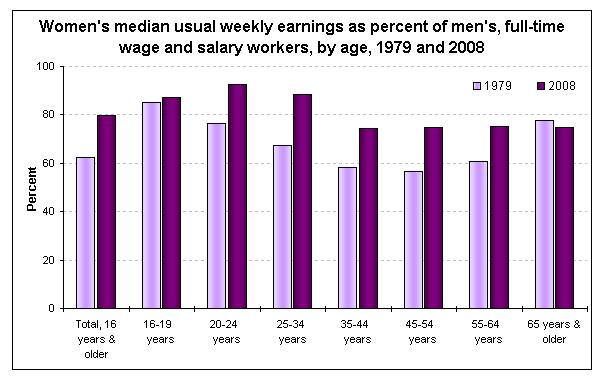The figure below, borrowed from U.S. News and World Report, shows that the wage gap between women and men, for nearly all age groups, has narrowed significantly between 1979 and 2008. It also shows that the wage gap is smallest for men and women aged 20-24, grows for men and women aged 25-34, grows even further for men and women aged 35-44, and remains steady after that.

These data are for men and women in the same jobs working full time. So what would explain this change? Sociologists have found that much of the growth in the wage gap over the life course is due to the fact that women are held disproportionately responsible for childcare and housework (see some data here). As men and women start to have children, women (whether by choice or necessity) find themselves sacrificing their careers more so than men. On the flip side, mothers are discriminated against by employers more often than fathers and women without children. (See, for example, this clip of Gov. Rendell commenting that Janet Napolitano is a good candidate for secretary of Homeland Security because she has no family.) That’s why you see the wage gap increasing during prime childbearing years (25-44), but not afterward.
For more on the wage gap, see our posts on the wage gap for college grads, comparing different kinds of wage gaps, the role of job segregation, gender and the wage gap in different professions.
—————————
Lisa Wade is a professor of sociology at Occidental College. You can follow her on Twitter and Facebook.

Comments 8
Annoyed — September 6, 2009
There has been so much research on the wage gap for the middle years. We all know that women are under more pressure to have a clean house and take care of the kids while men are under more pressure to work late and advance their career. Meanwhile both would probably prefer a better balance of both.
I am really interested in why there is such a big gap in the high school years, and why high school work is so gendered. I wonder if teens are still trying so hard to fit in that they won't break gender barriers. Or is it mostly due to who is hiring them. Restaurants want cute girls at the counter (which pays less) and parents still predominantly hire girls to babysit.
Yummy dummy « Prosalosa — September 7, 2009
[...] sikkert over den nye rollen, men innser at jobben er for stressfylt før barnet begynner på skolen og trapper ned karrieren. Styreleder ble hun hvertfall ikke, man kan som sagt ikke være uunnværlig både på arbeid og [...]
Grizzly — September 8, 2009
"...due to the fact that women are held disproportionately responsible for childcare and housework (see some data here). As men and women start to have children, women (whether by choice or necessity) find themselves sacrificing their careers more so than men."
The wording of your comments emphasizes the sacrifices of the women, and ignores those of the man. Why not say something like this:
"...due to the fact that men are held disproportionately responsible for wage earning. As men and women start to have children, men(whether by choice or necessity) find themselves sacrificing time with their families more so than women."
splack — September 9, 2009
There sure is a lot of pushback in the comments on SI's posts that focus on gender.
Bending Gender Online for Fun, Profit, and Faux Feminism « Kittywampus — December 16, 2009
[...] years, if they’ve chosen to have kids. This chart (from U.S. News and World Report, via Sociological Images) shows that progress has been made only for young (and mostly childless) women. The pay gap opens [...]